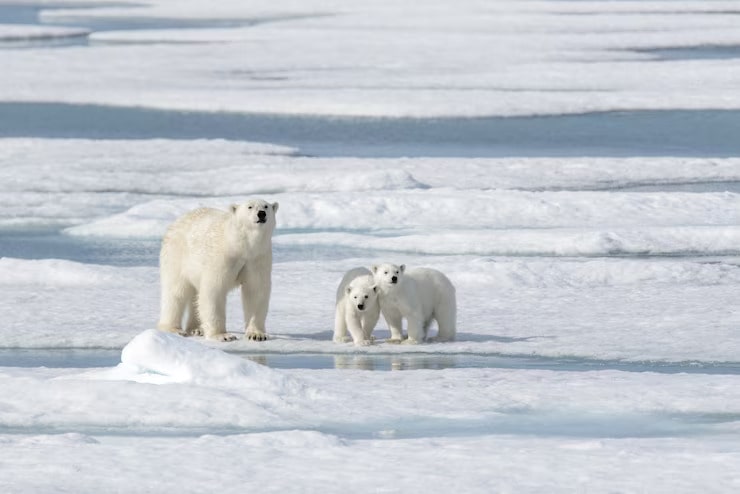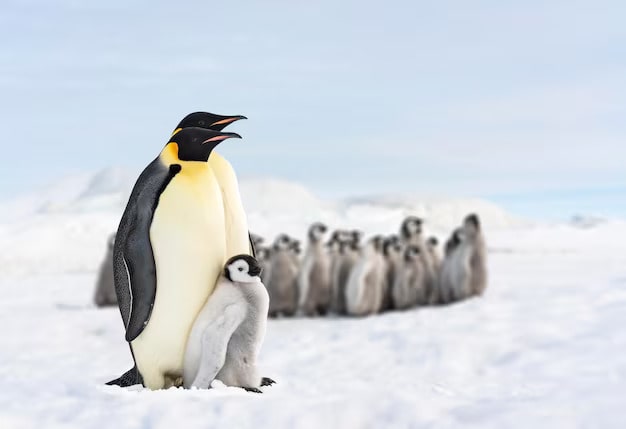Exploring the Enigmatic Polar Regions: A Journey to the Ends of the Earth
My Solo Trip to Antarctica
My Solo Trip to AntarcticaWelcome to the breathtaking world of the Polar Regions, where snow and ice dominate the landscape, and the stunning natural beauty is matched only by the extreme conditions that exist there. This article will take you on a virtual journey to the two most iconic polar regions on our planet – the Arctic and Antarctica. These remote destinations have fascinated explorers, scientists, and adventure seekers for centuries. We’ll delve deep into the unique characteristics, wildlife, cultures, and the importance of these regions, providing you with a comprehensive guide to your next polar adventure.
The Arctic – The Frozen North
1.1 Arctic Geography
The Arctic is a vast region situated in the northernmost part of our planet. Encompassing the Arctic Ocean, parts of Canada, Greenland, Alaska, Russia, and more, this region is known for its immense ice sheets, glaciers, and stunning fjords. It is an extraordinary ecosystem teeming with wildlife and natural wonders.
The Arctic landscape is dominated by glaciers, icebergs, and tundra, creating a unique and captivating environment. You’ll experience the magic of the midnight sun during the summer months and the mesmerizing Northern Lights during the winter.
1.2 Arctic Wildlife
One of the main attractions of the Arctic is its unique wildlife. From polar bears and Arctic foxes to various species of seals and whales, this region offers a chance to witness some of the world’s most magnificent creatures. We’ll delve into the incredible adaptations that allow these animals to thrive in such harsh conditions.

Polar bears, the charismatic symbol of the Arctic, are best spotted on ice floes, where they hunt for seals. Arctic foxes, with their thick winter coats, are a common sight in the tundra, and the Arctic’s waters are home to a rich diversity of marine life, including seals and whales.
1.3 Indigenous Cultures
The Arctic is home to numerous indigenous cultures, such as the Inuit, Saami, and Chukchi. We’ll explore their rich traditions, languages, and the challenges they face in preserving their way of life in the modern world.
The Inuit people, for instance, have a deep connection to the land and sea, with hunting and fishing playing a central role in their culture. Visitors can engage in cultural exchanges, learning about their traditional practices, art, and storytelling.
1.4 Climate Change in the Arctic
The Arctic is particularly vulnerable to the effects of climate change. We’ll discuss the ongoing environmental challenges in the region and their global implications, as well as the efforts to mitigate and adapt to the changing conditions.
Melting ice, rising temperatures, and shifting ecosystems in the Arctic have far-reaching consequences. We’ll explore the impact of these changes on the environment, wildlife, and indigenous communities, and the initiatives aimed at preserving this unique region.
Part 2: Antarctica – The Frozen Continent

2.1 Antarctica’s Geography
Antarctica, the southernmost continent, is a vast land of ice and snow. It is the coldest, driest, and windiest place on Earth, and it’s surrounded by the Southern Ocean. We’ll explore its dramatic landscapes, including towering icebergs and stunning ice shelves.
Antarctica’s awe-inspiring landscapes include massive icebergs, ice shelves, and towering mountains. The continent’s untouched beauty is a testament to its isolation, with landscapes that seem surreal and otherworldly.
2.2 Antarctic Wildlife
Antarctica is home to a diverse array of wildlife, such as penguins, seals, and seabirds. We’ll take a closer look at these incredible creatures and their unique adaptations for survival in this extreme environment.

Penguins, like the Emperor and Adélie penguins, are iconic inhabitants of Antarctica. You can witness their colonies during the breeding season, which is a remarkable experience. Seals, including the Weddell and Ross seals, can also be found basking on the ice, while various seabirds fill the skies.
2.3 Scientific Research in Antarctica
The Antarctic region serves as a vital hub for scientific research. We’ll delve into the groundbreaking studies conducted in this region, including climate research, geology, and the study of extremophiles.
Antarctica is a living laboratory for scientists studying climate change, with ice cores offering valuable insights into Earth’s history. Geologists explore the continent’s rock formations to better understand our planet’s past. Moreover, extremophiles, resilient microorganisms, are studied for their potential applications in biotechnology.
2.4 The Antarctic Treaty
Antarctica is a continent dedicated to peace and science. We’ll discuss the Antarctic Treaty System, which regulates human activity on the continent and preserves its pristine environment.
The Antarctic Treaty, signed by numerous countries, ensures that the continent remains a place of scientific cooperation and environmental protection. Visitors to Antarctica are bound by strict guidelines to minimize their impact on this fragile ecosystem.
Part 3: Preparing for Your Polar Adventure
3.1 Traveling to the Polar Regions
Getting to the polar regions can be an adventure in itself. We’ll provide an overview of transportation options, including cruises, expeditions, and necessary permits.
To visit these remote regions, travelers can choose from various options, including expedition cruises, research vessels, and air travel. Obtaining permits and understanding visa requirements are crucial steps in the planning process.
3.2 Packing Essentials
To survive in these harsh environments, you’ll need the right gear and clothing. We’ll create a comprehensive packing list to ensure you’re well-prepared for your journey.
Packing for a polar expedition involves warm clothing, waterproof gear, sturdy boots, and other essentials to stay comfortable in extreme cold. We’ll provide a detailed checklist to help you pack efficiently.
3.3 Safety and Health
Safety is a top priority when traveling to the polar regions. We’ll discuss health precautions, emergency procedures, and guidelines for responsible tourism.
Staying safe in these challenging environments is essential. We’ll cover important safety measures, including medical checks, emergency response plans, and tips for responsible wildlife viewing.
Part 4: Frequently Asked Questions (FAQ)
Q1: When is the best time to visit the Polar Regions?
A1: The best time to visit the Polar Regions varies depending on your interests. In the Arctic, summer (June to August) is ideal for wildlife sightings and outdoor activities. In Antarctica, the austral summer (November to February) offers milder conditions and the opportunity to witness wildlife.
Q2: How can I minimize my environmental impact when visiting these fragile ecosystems?
A2: Minimize your impact by choosing responsible tour operators, following Leave No Trace principles, and respecting wildlife and indigenous cultures. Use eco-friendly products, reduce waste, and participate in conservation initiatives.
Q3: Are there any restrictions on photography and wildlife interaction?
A3: Yes, there are strict guidelines to protect wildlife. Keep a safe distance from animals, avoid disturbing them, and follow photography regulations to safeguard their natural behavior.
Q4: What are the main differences between the Arctic and Antarctica?
A4: The Arctic is an ocean surrounded by land, while Antarctica is a continent surrounded by water. The Arctic is inhabited and accessible year-round, whereas Antarctica is more isolated and visited mainly during the summer.
Q5: Can I visit both the Arctic and Antarctica on a single trip?
A5: Some expedition cruises offer itineraries that explore both regions, but it’s a challenging and costly endeavor. Most travelers choose to visit them separately due to the logistical complexities.
Q6: What are the costs associated with polar travel, and are there budget-friendly options?
A6: Polar travel can be expensive due to remote locations and logistics. However, some budget-friendly options, like last-minute deals and shared accommodations, are available. Plan and book well in advance for cost savings.
Q7: Is it safe to travel to these remote regions?
A7: Traveling to the Polar Regions is generally safe with experienced tour operators. However, it’s essential to follow safety guidelines, receive proper training, and be prepared for the harsh conditions.
Q8: Are there any unique cultural experiences available to tourists in the polar regions?
A8: Yes, you can engage in cultural exchanges with indigenous communities, learn about their traditions, and purchase unique handicrafts. However, always respect their privacy and traditions.
Q9: How can I support conservation efforts in the Polar Regions?
A9: Support conservation organizations and initiatives dedicated to preserving these regions. Contribute to research and engage in sustainable practices during your visit.
Q10: What should I expect from a polar expedition cruise, and how do I choose the right one?
A10: Polar expedition cruises offer guided tours, wildlife viewing, and educational programs. Choose a cruise based on your interests, the level of comfort you desire, and the expertise of the guides.
Your journey to the Polar Regions promises to be a once-in-a-lifetime adventure filled with awe-inspiring landscapes, unique wildlife, and profound cultural experiences. Whether you’re drawn to the Arctic’s pristine wilderness or Antarctica’s otherworldly beauty, these remote destinations are sure to leave an indelible mark on your soul. Make your travel plans with careful consideration of the environment and respect for the indigenous cultures, and you’ll return home with memories that will last a lifetime. Get ready to embark on a polar expedition like no other!

